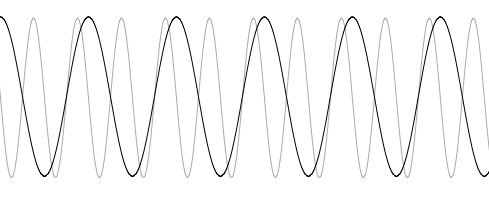by Benjamin Coy
Discussion about “lowered thirds,” “just intonation,” and “equal temperament” can be found just about anywhere, from orchestras to chamber ensembles to conservatories. However, the number of incomplete or inaccurate descriptions I’ve seen indicates that much confusion surrounds these concepts and how they relate to performance.
Intonation, and in fact all sound, can be reduced to a pretty simple measurement of air pressure. Sound waves are repetitive, quick changes in air pressure; harmonies are created by various pressure oscillation patterns interacting with each other. For instance, here is a graph of two very simple sound waves:

Note that the black wave moves half as fast as the gray one. Every cycle of the black wave meets with the gray wave in exactly the same way; this graph could be extended infinitely and experience no changes. The two sound waves combine to form an interval in the ear with no irregularities, resulting in a simple, repetitive result wave that looks like this:

However, if we change the speed of the gray wave just slightly so that it doesn’t interact with the black wave identically in each cycle, we create a very different situation. First, here are the two waves separately:

And combined:

The human ear hears these irregularities as dissonant and out of tune. To make intervals in tune, therefore, one must play two notes whose sound waves have a repeating pattern relative to each other, like the first example where the black wave was twice as slow as the gray one. In mathematical terms, the frequencies (or speeds) of the two waves must form a simple integer ratio.
The problem with this system is that the pitch of each note can vary slightly depending on how the frequency is calculated. For instance, a C sharp calculated as the third of A 440 is 550 Hz (or cycles per second). However, if that C sharp (or rather, its enharmonic D flat) is calculated as the minor 6th of F, it has a frequency of 563.2 Hz. The difference is doable on instruments like the violin or the trombone that can adjust each pitch appropriately, but fixed-pitched instruments like the piano do not have this flexibility.
To make fixed-pitch instruments playable, each note of the chromatic scale is altered, or “tempered,” to be slightly out of tune. Each tempered note has a frequency somewhere in the middle of all possibilities for that note, and works well enough in most intervals without being perfect for any. Strategies for altering the scale for this purpose are called temperaments.
A vast array of temperaments have been practiced throughout the history of western music. Early temperaments emphasized the purity of certain intervals at the expense of others. For instance, “mean-tone” temperament was popular with organists in the sixteenth century because it had many perfectly tuned major thirds and made chorales in certain keys sound very pure. However, these temperaments sacrificed the usability of some other keys to achieve that purity. Instruments tuned in this way could only be played in certain keys.
By the Baroque period, composers needed more flexible instruments, and a new system of “well temperament” was developed. Well temperament still emphasized the purity of common keys, but further adulterated them in order to make the other keys at least playable. Bach wrote his Well-Tempered Clavier to demonstrate the character of instruments using this tuning system.
In the late sixteenth century, mathematicians described an “equal temperament,” a system in which all pitches were tempered the same amount, and all keys were equally playable. However, the technology necessary to tune instruments to this standard did not become practical until the mid-nineteenth century. At that point, equal temperament gradually overtook well temperament and became the normal tuning method for fixed pitch instruments. Equal temperament is now the de-facto standard and is used with pianos, percussion instruments, and electronic tuners.
To help demonstrate the difference between equal temperament and untempered intonation, let’s consider a C major triad. Listen to this recording of the chord calculated without temperament while looking at its graph.

Here is the same C major chord again, only this time I used equal temperament to calculate the pitch frequencies. Once again, listen to the recording of the equal tempered chord and look at its graph. In particular, listen to the subtle “wah-wah” effect (or beating) in this second sound file. If your environment has too much ambient noise for this effect to be easily audible, try using headphones. The effect is not vibrato – it is caused by the conflicting sound waves of slightly mistuned notes.

The equal tempered chord is still recognizably C major, and on a percussive instrument like a piano, the sound dies away before the beating becomes overly noticeable. Especially when playing highly chromatic music, the disadvantages of this temperament are more than offset by the ability to play in all keys without major intonation flaws.
As trombonists, however, we are left with a problem. We live in a world filled with pianos and electric tuners, all of which adhere to an intonation system which at its core is out of tune, and yet we play resonant, sustaining instruments which can make the beating caused by tempered intonation very apparent. Both equal temperament and untempered intonation are useful tools, but neither should be applied indiscriminately.
When playing a sonata or something with piano accompaniment, it will be in our best interest to use equal temperament — basically, we should tune to the piano, or we will sound out of tune by comparison. However, in an orchestral environment, where nearly all the instruments have the ability to bend pitches into tune, untempered intonation will create a much purer sound. Putting an electric tuner on the stand and keeping the needle in the middle does nothing but guarantee an out of tune performance.
Do yourself a favor: put the tuner away, and listen. Your ears are far more accurate than the electronics.